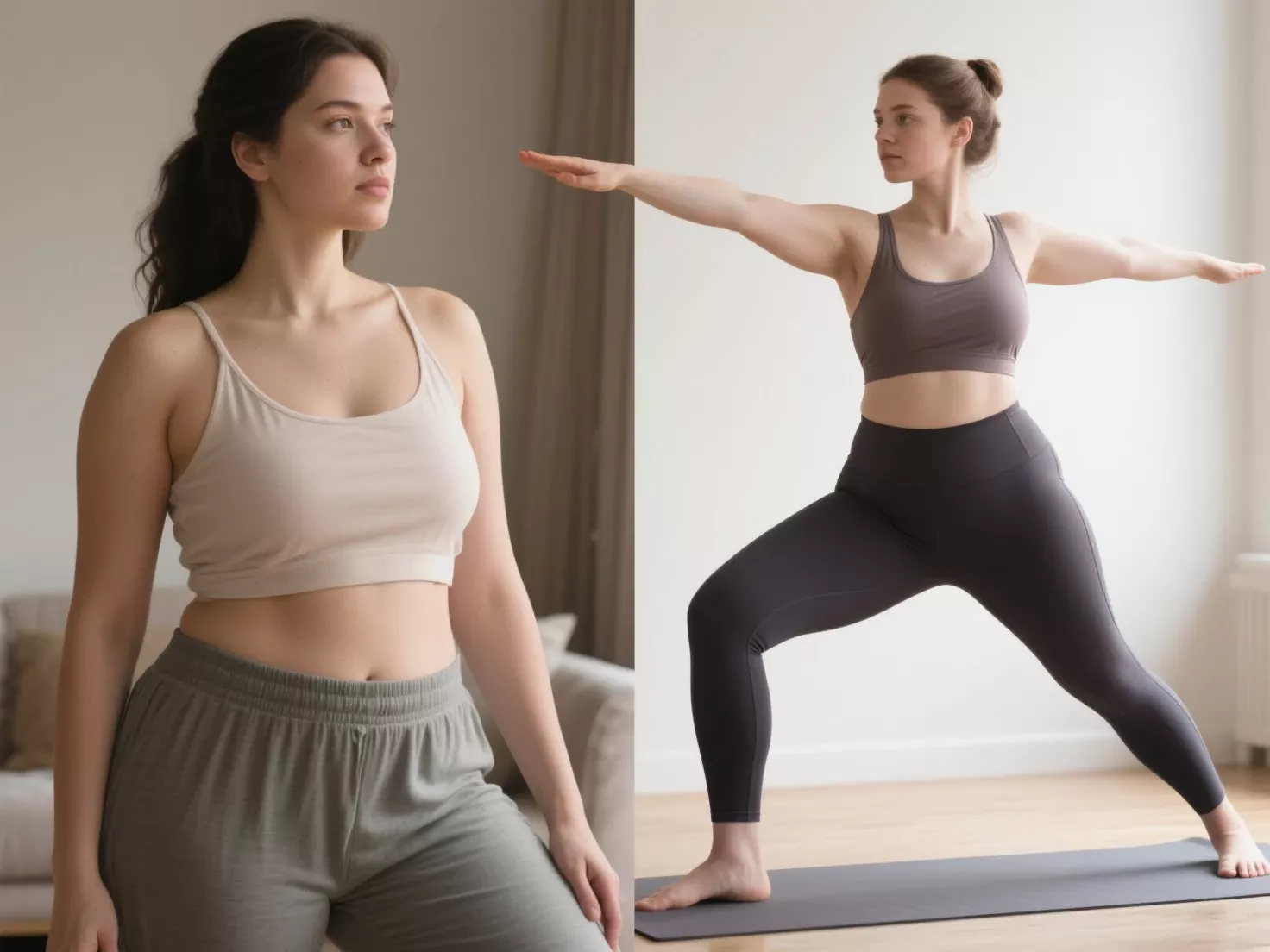Yoga is often portrayed in the media as a practice reserved for thin, ultra-flexible individuals twisting themselves into pretzel-like positions.
But this image could not be further from the truth. Yoga is a centuries-old discipline that welcomes people of all shapes, sizes, and fitness levels.
That said, it’s important to acknowledge that overweight individuals may face unique challenges when starting yoga — but these challenges are far from barriers.

With the right approach, yoga can be one of the most inclusive, adaptive, and beneficial practices for individuals with larger bodies.
So, is yoga harder for overweight people? The answer is nuanced.
Physically, some poses may initially feel more demanding, but emotionally and spiritually, yoga can offer even deeper rewards. Let’s explore this topic in detail.
💭 Common Perceptions vs. Reality
Perception: Yoga is only for the slim and flexible.
Reality: Yoga is for every body — including those with curves, extra weight, or limited mobility.
While it may look effortless when practiced by experienced yogis, everyone starts somewhere, and being overweight doesn’t exclude anyone from experiencing the full benefits of yoga.
In fact, many overweight people thrive in yoga with the right modifications and mindset.
🧘♀️ Physical Challenges Overweight Yogis Might Face
It’s true that larger bodies may experience some initial physical obstacles. Here are the most common ones — and how to overcome them:
1. Joint Pressure and Mobility
Extra body weight can place more strain on joints, especially the knees, wrists, hips, and ankles.
This can make weight-bearing poses like Plank or Downward Dog more uncomfortable.
Solution: Use props such as yoga blocks, bolsters, and chairs to reduce strain. Also, start with gentle or restorative yoga to build foundational strength.
2. Balance and Core Stability
Poses that require balance, like Tree Pose or Warrior III, may feel difficult if the core muscles are underdeveloped or if weight is unevenly distributed.
Solution: Practice near a wall or use a chair for support. Balance improves with time and consistent practice.
3. Restricted Range of Motion
The presence of belly fat, large thighs, or a fuller chest can restrict movement in poses like Seated Forward Fold or Twist.
Solution: Modify the pose — spread your legs wider, use a strap to reach your feet, or place a cushion between your belly and thighs to create space.
4. Breath Control and Stamina
Carrying extra weight can make breath control more difficult and lead to quicker fatigue.
Solution: Incorporate pranayama (breath work) and start with shorter sessions.
Even 15–20 minutes of gentle movement and conscious breathing offers benefits.
✅ Why Yoga Is Perfectly Suited for Overweight Bodies
Despite initial challenges, yoga offers powerful and lasting benefits for people in larger bodies — both physically and emotionally.
✨ 1. Low Impact Movement
Unlike running or high-intensity workouts, yoga is gentle on joints, reducing the risk of injury.
✨ 2. Customizable for Every Body
Yoga is endlessly adaptable. From Chair Yoga to Restorative Yoga, there are styles and sequences that cater to every physical condition and comfort level.
✨ 3. Improves Flexibility and Strength Gradually
You don’t have to be flexible to start yoga — that’s a result, not a requirement. Yoga builds strength, improves range of motion, and enhances functional mobility.
✨ 4. Reduces Stress and Emotional Eating
Practicing yoga regularly helps reduce cortisol (the stress hormone), which is linked to emotional eating and abdominal fat retention.
Mindfulness gained through yoga also promotes healthier relationships with food and body image.
✨ 5. Boosts Self-Acceptance and Body Confidence
Yoga teaches you to listen to your body with compassion. You learn that your body is not a problem to be fixed — it’s a powerful vessel for breath, movement, and life.
🔧 Pose Modifications for Larger Bodies
| Traditional Pose | Modification for Comfort |
|---|---|
| Downward Dog | Use blocks under hands or do against the wall |
| Child’s Pose | Keep knees wide apart; place a bolster under the chest |
| Seated Forward Fold | Sit on a folded blanket, bend knees, or use a strap |
| Twists | Sit tall, twist gently with hand on hip or thigh |
| Plank Pose | Drop knees or do on forearms |
| Warrior Poses | Shorten the stance and use a chair for balance if needed |
Tip: Always prioritize comfort and breathability over “perfect” form.
🧠 Emotional Challenges and How to Navigate Them
❌ Fear of Judgment
Many overweight individuals fear being judged in a yoga studio filled with thin, athletic people.
Remedy: Seek out body-positive studios or practice at home with inclusive online classes. Many wonderful instructors focus on yoga for plus-size bodies.
❌ Negative Body Image
Comparing your body to others can damage confidence.
Remedy: Focus on how you feel, not how you look. Celebrate progress, no matter how small.
❌ Imposter Syndrome
Thinking “I’m too big to be a real yogi.”
Remedy: Remember that yoga is a mindset, not a shape. Every breath you take in mindful movement is yoga.
🌟 Success Stories That Inspire
-
Jessamyn Stanley – A globally recognized yoga teacher who promotes yoga for all bodies. Her book “Every Body Yoga” is empowering and relatable.
-
Dianne Bondy – Founder of Yoga For All, she advocates for body positivity and inclusion in yoga spaces.
-
Amber Karnes – Creator of Body Positive Yoga, offering online classes and accessible content for larger-bodied practitioners.
These individuals show that yoga is about connection, not appearance.
🙋♀️ FAQs
1. Can overweight people become flexible and strong with yoga?
Yes. Flexibility and strength are built with consistent practice — body size does not determine your potential.
2. Will yoga help with weight loss?
Yoga supports weight loss indirectly by reducing stress, improving sleep, and fostering a mindful lifestyle.
Active styles like Power Yoga or Vinyasa can help burn calories, but the deeper benefit lies in long-term wellness.
3. What’s the best style of yoga for beginners with larger bodies?
Start with Hatha, Chair Yoga, Restorative, or Gentle Flow. As your strength builds, explore Vinyasa or Yin Yoga.
4. Should I talk to the teacher before joining a class?
Absolutely. A good instructor will offer modifications and make you feel welcome. Don’t hesitate to share any limitations or concerns.
🌈 Final Thoughts: Yoga Is for Every Body
Yes, yoga may present initial physical or emotional challenges for overweight people — but it is not harder in the sense of being impossible or exclusive.
With proper support, modifications, and patience, yoga becomes a powerful, healing practice that nurtures the body and mind at every size.
“You don’t have to be thin to be strong. You don’t have to be flexible to be graceful. You don’t have to change your body to find your power. You just have to show up.”
The mat is a space of non-judgment. Your breath is your teacher. Your journey is valid — exactly as you are.



